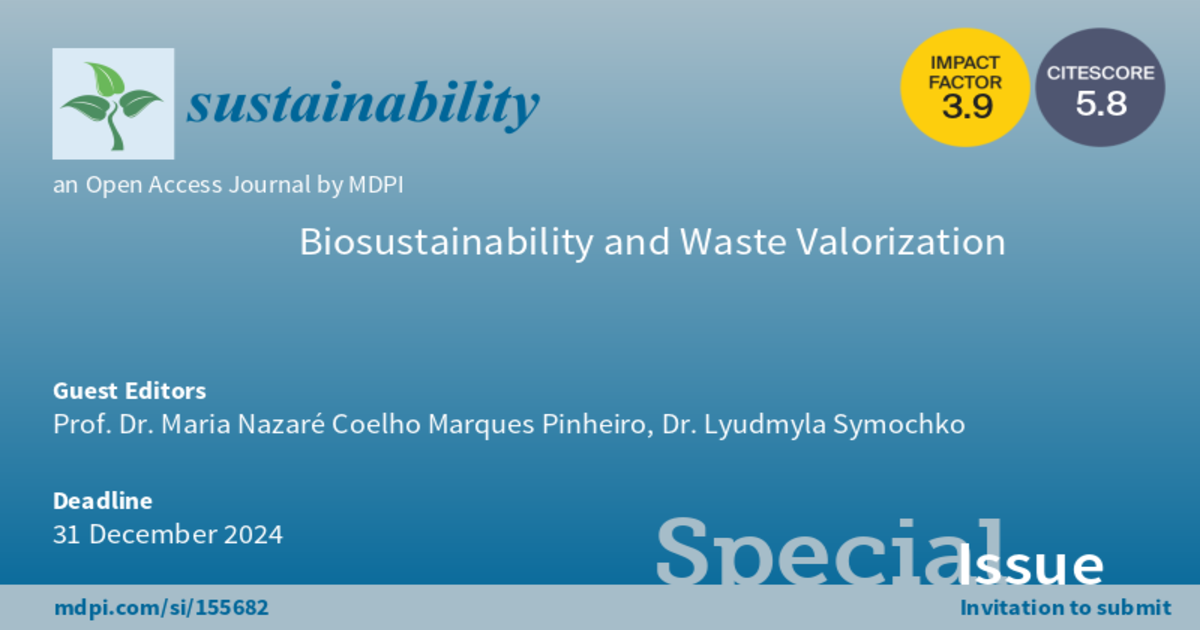Biosustainability and Waste Valorization
A special issue of Sustainability (ISSN 2071-1050). This special issue belongs to the section "Waste and Recycling".
Deadline for manuscript submissions: closed (31 May 2025) | Viewed by 33818

Special Issue Editors
Interests: waste valorization; bioresources recycling; separation processes; transport phenomena
2. Faculty of Biology, Uzhhorod National University, 88000 Uzhhorod, Ukraine
Interests: food security; soil science; ecosystem management; sustainability; environmental microbiology; ecology
Special Issue Information
Dear Colleagues,
Sustainable development and quality of life associated with less consumption of bioresources must be the new paradigm. Good practices such as the recycling and valorization of bioproducts and waste are essential to the circularity of the bioresource economy. It is crucial that the challenges of consciousness development toward sustainability are based on concerted actions to safeguard bioresources. The implementation of green chemistry approaches in industry and agriculture will allow to reduce their negative impact on the environment and promote sustainable development. Biodiversity preservation and the management of ecosystems, the responsible production and consumption of food, energy, and water, and the adoption of sustainable agricultural, forest, and marine activities are some fundamental actions to reach sustainable development goals.
We welcome case studies with practical research results and reflections/discussion addressing the following topics:
- Agriculture waste valorization;
- Forest waste valorization;
- Green chemistry approaches for waste valorization;
- Ecosystem management and sustainability;
- Water and soil quality;
- Food system optimization and food security;
- Soil integrity preservation;
- Marine ecosystem sustainability;
- Management and innovative uses of local bioresources.
Prof. Dr. Maria Nazaré Coelho Marques Pinheiro
Dr. Lyudmyla Symochko
Guest Editors
Manuscript Submission Information
Manuscripts should be submitted online at www.mdpi.com by registering and logging in to this website. Once you are registered, click here to go to the submission form. Manuscripts can be submitted until the deadline. All submissions that pass pre-check are peer-reviewed. Accepted papers will be published continuously in the journal (as soon as accepted) and will be listed together on the special issue website. Research articles, review articles as well as short communications are invited. For planned papers, a title and short abstract (about 100 words) can be sent to the Editorial Office for announcement on this website.
Submitted manuscripts should not have been published previously, nor be under consideration for publication elsewhere (except conference proceedings papers). All manuscripts are thoroughly refereed through a single-blind peer-review process. A guide for authors and other relevant information for submission of manuscripts is available on the Instructions for Authors page. Sustainability is an international peer-reviewed open access semimonthly journal published by MDPI.
Please visit the Instructions for Authors page before submitting a manuscript. The Article Processing Charge (APC) for publication in this open access journal is 2400 CHF (Swiss Francs). Submitted papers should be well formatted and use good English. Authors may use MDPI's English editing service prior to publication or during author revisions.
Keywords
- bioproducts valorization
- waste valorization
- bioresources
- sustainability
- food security
- ecosystem management
Benefits of Publishing in a Special Issue
- Ease of navigation: Grouping papers by topic helps scholars navigate broad scope journals more efficiently.
- Greater discoverability: Special Issues support the reach and impact of scientific research. Articles in Special Issues are more discoverable and cited more frequently.
- Expansion of research network: Special Issues facilitate connections among authors, fostering scientific collaborations.
- External promotion: Articles in Special Issues are often promoted through the journal's social media, increasing their visibility.
- Reprint: MDPI Books provides the opportunity to republish successful Special Issues in book format, both online and in print.
Further information on MDPI's Special Issue policies can be found here.






